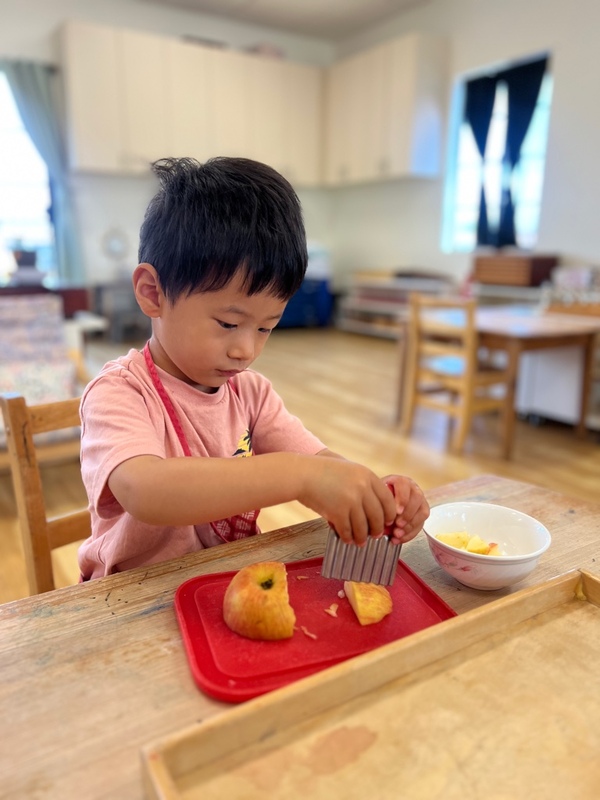(858) 759-0631
Lunch is not usually regarded as an important meal of the day. In the scope of things, breakfast is always touted as important because it’s the first meal you start with, and dinner is important because that is the time you get to spend together as a family. Lunch, in the meantime, gets only snippets of our attention, and we usually spend it eating at a desk, in front of a computer, or on our phone (I am guilty of that).
However, in the Montessori Environment, lunch is an experience for the child. The different aspects of setting up their lunch, eating and socializing, and cleaning up, are all culminations of behaviors that they have learned in the environment. In our classroom, each child is responsible for setting up lunch. As the lights in the classroom go off, the children start their lunchtime routine. They take the chairs and tables and set them around the classroom. Sometimes they require assistance in understanding where the chairs or tables need to go and they ask for help from an adult; other times another child sees them struggling and offers assistance. This is a great example of the communication we strive for the children to have, the ability to understand their limitations and ask for help but also the ability to offer their assistance to their community members. The placemat also gives the child an idea of where their personal space is. This is similar to when we use a rug in the classroom. The child knows that only their things belong in the space of the placemat, and so they will not place things outside of the placemat and they will not infringe on another child’s space. After they set up their placemat, they go to the shelf and get a plate, a fork, a spoon, and a glass of water. Each of these things is brought to the table, one at a time, so that the child understands the fragility of the items as well as the patience that it takes to set up their lunch. After setting up the items, they get their lunchbox and set up the food, from their lunchbox onto their plate. If the child chooses, they may warm their lunch on the plate in the microwave. After they have set up their lunch, they wait behind their chairs until all the children in the class have set up their lunch. We then sing our song, to express our gratitude for our food and start to eat.
As the children eat their lunch, they talk to the people around them. They converse about what their favorite color is, what they did during the day, and what they have for lunch. The number of curious questions we get about our food, such as “Did your mommy make it? Is it spicy? Why is it purple? Do you like it?” encourages the conversations we have about healthy eating. We explain to the children the different ways we cook food if we go out to eat with our families, and what foods we like or haven’t tried. The biggest thing that we have done, that encourages trying new food, is talking about the new food that we haven’t eaten yet. The final step in our lunchtime routine. Each child is responsible for cleaning up. They place their utensils in the dishwasher, after carefully washing the excess food off of the plate. They sweep the classroom, place chairs on tables, arrange lunch boxes or placemats as well as help younger friends. The whole process for lunch takes 45 minutes to an hour.
I want to stress how important it is for your child to eat lunch at school with us. It builds their independence to feed themselves and builds their relationships with the other students. Sending a variety of food excites your child because they can relate to other children who may bring that same food. I encourage you to change up your child’s lunch. Invite them to help you pack their lunch. Encourage them to pick out the food they want to eat, by giving them two choices (an apple or an orange) so this way the decision goes back to them. It can be a discussion about choosing healthy foods to give us our energy for the day as well as an opportunity to discuss our eating habits. Being able to pick their food doesn’t allow them to say that they didn’t like it, so they didn’t want to eat it. As for picky eaters, we encourage them to try one bite of the food they have been given. If they choose to not eat the whole thing, that is fine. We want to expose them to the food. We don’t stop at giving them the one bite though. It’s a journey to appreciate the food. Consistent exposure to the food will allow the child to understand that it’s something that their parents will not give up on. Find different ways of presenting the food. Come up with games to prepare the food with your child.
I encourage you to have discussions with your children about their lunchtime and their activities. Talk to them about what they liked about their lunch and what they didn’t.
-Caterpillar Teacher
This child is preparing lunch independently at our educational Transitional Kindergarten (TK) program.

